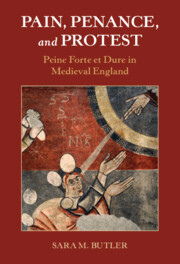Book contents
- Pain, Penance, and Protest
- Studies in Legal History
- Pain, Penance, and Protest
- Copyright page
- Contents
- Tables
- Acknowledgments
- Table of Statutes
- Abbreviations
- Introduction
- 1 Peine Forte et Dure: The Medieval Practice
- 2 Standing Mute in the Courts of Medieval England
- 3 Due Process and Consent to Jury Trial
- 4 Peine Forte et Dure as Barbarity? Putting the Practice in Context
- 5 Why Stand Mute?
- 6 Standing Mute as Imitatio Christi
- 7 Rejecting the Jury, Rejecting the Common Law, Rejecting the King
- Conclusion
- Bibliography
- Index
- Pain, Penance, and Protest
- Studies in Legal History
- Pain, Penance, and Protest
- Copyright page
- Contents
- Tables
- Acknowledgments
- Table of Statutes
- Abbreviations
- Introduction
- 1 Peine Forte et Dure: The Medieval Practice
- 2 Standing Mute in the Courts of Medieval England
- 3 Due Process and Consent to Jury Trial
- 4 Peine Forte et Dure as Barbarity? Putting the Practice in Context
- 5 Why Stand Mute?
- 6 Standing Mute as Imitatio Christi
- 7 Rejecting the Jury, Rejecting the Common Law, Rejecting the King
- Conclusion
- Bibliography
- Index
Summary
In 1586, after prolonged deliberation and with great reluctance, Justices Clench and Rhodes, sitting in judgment at the Castle of the Common Hall in York, ordered the execution of the recusant, Margaret Clitheroe (also, Clitherow). Her offense was a distinctly post-Reformation one: she was charged with harboring Catholic priests, a crime for which she was most surely guilty, having constructed a hidden room in her neighbor’s home where multiple well-known Catholic dissenters had taken refuge. Harboring of this kind was also a newly legislated felony, having been enacted at parliament a year prior. The evidence poised against her was slim, resting principally on the confession of a young Flemish boy schooled in her home, whom city authorities had browbeaten and manhandled until he agreed to guide them to the concealed room. The presence of chalices and vestments there hinted at the enormity of Margaret’s wrongdoing. Yet, not having encountered an actual priest in residence, authorities had only the boy’s testimony to substantiate that Margaret had in fact sheltered priests there in the past. If she had been tried, in all likelihood, as the justices continually assured her, she would have been acquitted.
- Type
- Chapter
- Information
- Pain, Penance, and ProtestPeine Forte et Dure in Medieval England, pp. 1 - 25Publisher: Cambridge University PressPrint publication year: 2021



